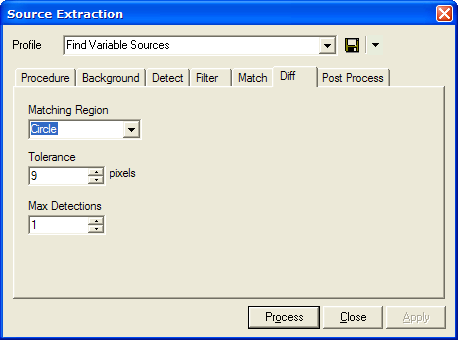
Difference page
The Difference page of the Source Extraction configures source list differencing for the Extract Sources command. When extracting from an image set, source list differencing removes sources that pass all the filtering criteria but are not located at the same coordinates in every image. In other words, this processing step produces a final list including only those objects that are found in some images but not in every image of the image set. Only the source coordinates are used as a matching criterion and properties such as luminance or shape are not involved. The Tolerance and Matching Region parameters control the area searched to establish whether there exists a coordinate match at each object location. Depending upon the application, you may or may not need to register the images before using source differencing.

When an image set is processed, these preferences determine how the source lists are matched.
|
Matching Region |
Specifies the shape of the region used to determine whether objects in each pair of images refers to the same object. The tolerance determines the size of the region. |
|
Tolerance |
The size of the region examined for object matching. |
|
Max Detections |
Specifies the number of images in which the source must be detected to be included in the final list. If a source is detected in more images than specified, then it is not included in the final list. This is useful for detection of moving objects. For example, if Max Detections = 2, and the object is detected at the same location in more than 2 images, then it is discarded from the final list. |
This operation is the complement of the matching operation, meaning that objects not matched are differenced. However, this method gives a slightly different result than the simple "set complement" because Matching requires an object to be located in every image whereas Differencing identifies objects that are not matched in a subset of the entire image set.